Tight-binding model
1. Bloch theorem
Let’s start with the Kohn-Sham (KS) equation which has the form of Schrödinger equation for non-interacting electrons.
(1) ![]()
where ![]() . In the crystalline system,
. In the crystalline system, ![]() is the electron potential in a crystal
is the electron potential in a crystal
(2) ![]()
where the summation runs over lattice vectors ![]() and all atoms
and all atoms ![]() in the unit cell.
in the unit cell. ![]() is the internal coordinates of the atom in the unit cell.
is the internal coordinates of the atom in the unit cell. ![]() is the lattice vector.
is the lattice vector.
![]() is a periodic function
is a periodic function
(3) ![]()
According to the Bloch theorem, the KS wave function ![]() has the form [1]
has the form [1]
(4) ![]()
In order to solve Eqn. (1), we can use the linear combination of atomic orbitals method (LCAO). Assuming
(5) ![]()
where ![]() is the atomic orbital index like s,
is the atomic orbital index like s, ![]() ,
, ![]() ,
, ![]() ,
, ![]() ,
, ![]() ,
, ![]() ,
, ![]() ,
, ![]() , etc..
, etc.. ![]() is the Bloch basis. Basically, those basis are not necessary orthogonal to each other. However, here we only consider the orthogonal basis which satisfies
is the Bloch basis. Basically, those basis are not necessary orthogonal to each other. However, here we only consider the orthogonal basis which satisfies ![]()
There are two choices of the Bloch basis ![]() due to the gauge freedom. The first gauge choice is
due to the gauge freedom. The first gauge choice is
(6) ![]()
where the atomic coordinates ![]() is taken in the Fourier transform. So we name it as “atomic gauge“.
is taken in the Fourier transform. So we name it as “atomic gauge“.
In the atomic guage, the KS equation (1) becomes
(7) 
Where
(8) 
![]() are the tight-binding parameters.
are the tight-binding parameters.
The second gauge choice is
(9) ![]()
where we only consider the lattice phase ![]() contribution. So we name it as “lattice gauge“. In the lattice gauge, the KS equation is the same as the atomic gauge [7], however, the matric elements are different.
contribution. So we name it as “lattice gauge“. In the lattice gauge, the KS equation is the same as the atomic gauge [7], however, the matric elements are different.
(10) 
Two different gauges will give you the same physics. However, the atomic gauge is more suitable for calculating properties related to the periodic part of Bloch functions ![]() [2]. We will show that later.
[2]. We will show that later.
a. Periodic condition
According to the Bloch theorem, the Bloch wave function is periodic in the momentum space. i.e.
(11) ![]()
where ![]() is the reciprocal lattice vector satisficating
is the reciprocal lattice vector satisficating ![]() . It is easy to prove that the following conditions
. It is easy to prove that the following conditions
(12) 
2. Tight-binding approximation (TBA)
Actually, the formalism of the tight-binding model is listed in the above section. The spirit of TBA is by expressing the Hamiltonian by using the localized orbitals. Such localized orbitals could be atomic orbitals or Wannier functions which can be constructed from the Bloch wave function obtained from the first-principles calculations. The TB parameters ![]() can be obtained by the fitting to the DFT energy bands or directly obtained by software like Wannier90.
can be obtained by the fitting to the DFT energy bands or directly obtained by software like Wannier90.
Once we have the TB parameters, many physical properties can be calculated. However, some properties which require the information of local coordinates ![]() can’t be obtained. Since we don’t have the exact expression of the local orbitals. In order to solve this problem, we have to build local orbitals. The simplest choice is the
can’t be obtained. Since we don’t have the exact expression of the local orbitals. In order to solve this problem, we have to build local orbitals. The simplest choice is the ![]() function which means
function which means ![]() is only non zero when
is only non zero when ![]() . Under this basis,
. Under this basis,
(13) ![]()
3. The periodic part of the Bloch function
The periodic part of the Bloch function is defined as ![]() .
. ![]() is the basis of
is the basis of ![]() model and is used in the Berry phase, Berry curvature, shift-current, non-linear optical response and anomalous Hall conductivity calculations. In this section, we will show you that the wave function
model and is used in the Berry phase, Berry curvature, shift-current, non-linear optical response and anomalous Hall conductivity calculations. In this section, we will show you that the wave function ![]() obtained from the atomic guage can be directly considered as
obtained from the atomic guage can be directly considered as ![]() in the TB formulism.
in the TB formulism.
Let’s rewrite the KS equation under the basis of ![]() , then Eq.(1) becomes
, then Eq.(1) becomes
(14) ![]()
Let’s define ![]() . The
. The ![]() can be expanded under the basis of
can be expanded under the basis of ![]() since
since ![]() at each
at each ![]() point.
point.
(15) ![]()
Here the coefficienct ![]() is the same as Equation (5). The KS eqation becomes
is the same as Equation (5). The KS eqation becomes
(16) 
We define
(17) 
It’s clearly that the matrix element is the same as that of using Bloch basis. Eventually, the eigenvectors ![]() are also the same with each other. If you want to use the full Bloch wave function or the periodic part of Bloch wave function, you need to take the basis into account which are shown in Eqn. (5) and (15). Let’s discuss the behavior of two gauge choices more deeply.
are also the same with each other. If you want to use the full Bloch wave function or the periodic part of Bloch wave function, you need to take the basis into account which are shown in Eqn. (5) and (15). Let’s discuss the behavior of two gauge choices more deeply.
4. More about “atomic gauge” and “lattice gauge”
Atomic gauge
The Bloch wave function is the combination of Eq.(5) and (6).
(18) ![]()
Under the assumption of Eq. (13), the periodic part of the Bloch basis ![]() becomes
becomes
(19) 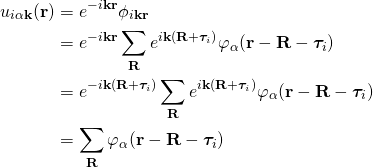
It’s amazing that the periodic part of the Bloch basis under the atomic gauge doesn’t dependent on the ![]() . So the k dependence of the wave function is included in
. So the k dependence of the wave function is included in ![]() which is element of the column vector of unitary matrix
which is element of the column vector of unitary matrix ![]() which makes
which makes ![]() (See Eqn.(17) and (8) ) diagonal
(See Eqn.(17) and (8) ) diagonal
(20) ![]()
Where ![]() is a diagonal matrix
is a diagonal matrix ![]() , The full periodic part of the Block wave function is
, The full periodic part of the Block wave function is
(21) ![]()
So in the atomic guage ![]() can directly be used as
can directly be used as ![]() . For example, if we want to calculate an overlap integral between
. For example, if we want to calculate an overlap integral between ![]() and
and ![]() , then
, then
(22) 
While the overlap between two Bloch wave functions ![]() and
and ![]()
(23) 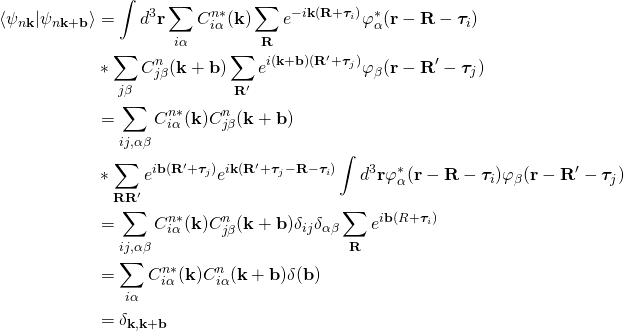
It means that the Bloch wave functions is orthogonal at different ![]() which is true.
which is true.
Lattice gauge
In order to get more intuition, let’s do the same thing as what we did for atomic gauge.
The Bloch wave function is the combination of Eq.(5) and (9).
(24) ![]()
Under the assumption of Eq. (13), the periodic part of the Bloch basis ![]() becomes
becomes
(25) 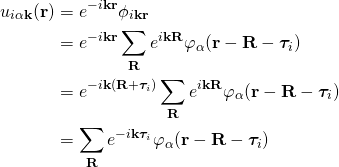
Unlike the atomic gauge case, here the periodic part of the Bloch basis under the lattice gauge does dependent on the ![]() . So the k dependence of the wave function not only is included in
. So the k dependence of the wave function not only is included in ![]() but also dependent on the basis. The full periodic part of the Block wave function is
but also dependent on the basis. The full periodic part of the Block wave function is
(26) ![]()
Let’s calculate an overlap integral between ![]() and
and ![]() , then
, then
(27) 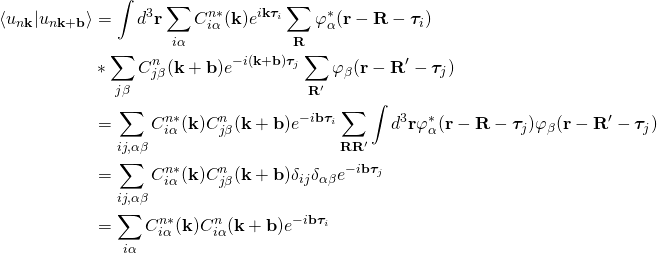
While the overlap between two Bloch wave functions ![]() and
and ![]()
(28) 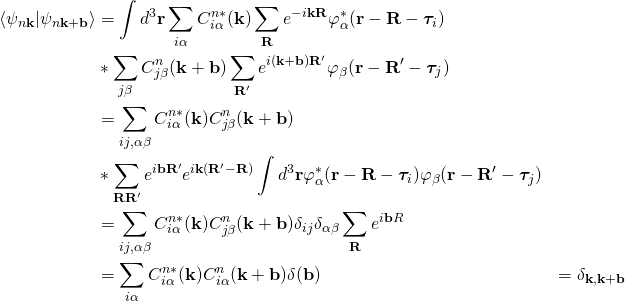
It means that the Bloch wave functions is orthogonal at different ![]() which is true. Here it’s worth to mention that
which is true. Here it’s worth to mention that ![]() in the lattice gauge is not analog to the Bloch wave function, since
in the lattice gauge is not analog to the Bloch wave function, since ![]() are not orthogonal between two different
are not orthogonal between two different ![]() points.
points.
[1] Kittel, Charles (1996). Introduction to Solid State Physics. New York: Wiley. ISBN 0-471-14286-7.
[2] Tight-Binding Formalism in the Context of the PythTB Package. Tahir Yusufaly, David Vanderbilt, and Sinisa Coh.
